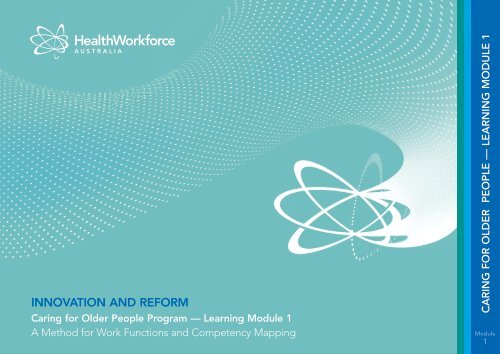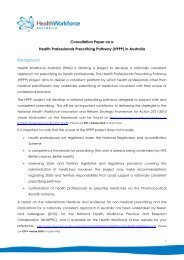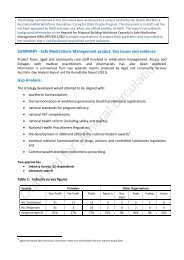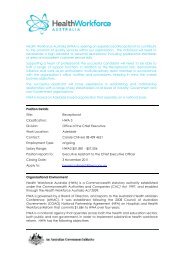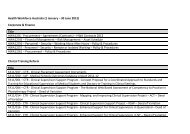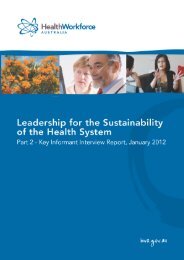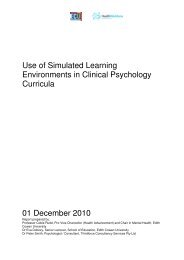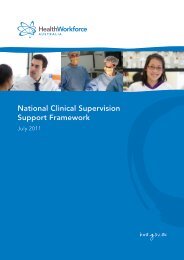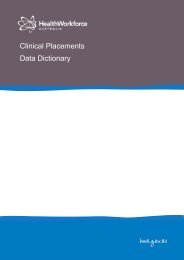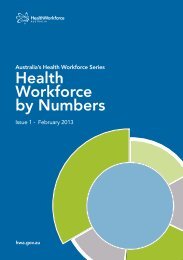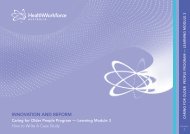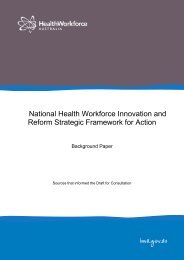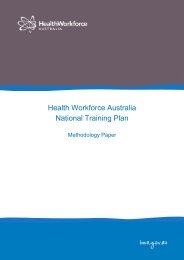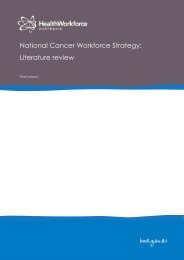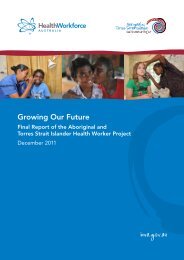A Method for Work Functions and Competency Mapping - Health ...
A Method for Work Functions and Competency Mapping - Health ...
A Method for Work Functions and Competency Mapping - Health ...
You also want an ePaper? Increase the reach of your titles
YUMPU automatically turns print PDFs into web optimized ePapers that Google loves.
=<strong>Work</strong><strong>for</strong>ce IssueWhich <strong>Functions</strong>are required?WhichCompetencies?Which Role?<strong>Work</strong><strong>for</strong>ce ModelINNOVATION AND REFORMCaring <strong>for</strong> Older People Program — Learning Module 1A <strong>Method</strong> <strong>for</strong> <strong>Work</strong> <strong>Functions</strong> <strong>and</strong> <strong>Competency</strong> <strong>Mapping</strong>
CONTENTS/OVERVIEWSET THINGS UP FOR SUCCESS — PREPARE WELL 51. AGREE YOUR WORKFORCE ISSUE 72. AGREE ON BEST PRACTICE TO DELIVER CLIENT CENTRED CARE 113. DEFINE THE WORKFORCE NEEDED TO DELIVER THE SERVICE MODEL 154. SUPPORT YOUR AGREED FUNCTIONS & COMPETENCIES 21CONTENTS/OVERVIEW5. IDENTIFY THE ENABLERS AND BARRIERS 256. GIVE IT A GO: PLAN, DO, STUDY, ACT (PDSA) 297. TELL US HOW IT WENT: DOCUMENT AND FEEDBACK 31RESOURCES AND BLANK TEMPLATES 33INNOVATION AND REFORMCaring <strong>for</strong> Older People Program — Learning Module 1A <strong>Method</strong> <strong>for</strong> <strong>Work</strong> <strong>Functions</strong> <strong>and</strong> <strong>Competency</strong> <strong>Mapping</strong>1
HOW TO USE THIS GUIDE2The objective of this guide is to provide the tools <strong>and</strong> guidance necessary to carry out thefollowing steps:1. Decide what your work<strong>for</strong>ce problem is2. Identify your key stakeholders in the process3. Decide what changes are needed to the patient journey to solve this problem (via the process map)4. Identify evidence or best practice initiatives which will support or in<strong>for</strong>m the development of your work<strong>for</strong>ce solution5. Develop the functions of the proposed work<strong>for</strong>ce role6. Identify <strong>and</strong> assess the applicability of relevant education <strong>and</strong> work<strong>for</strong>ce competencies7. Identify work<strong>for</strong>ce barriers <strong>and</strong> enablers <strong>for</strong> implementationWHO this resource is <strong>for</strong>Project officers involved in HWA Caring <strong>for</strong> Older People demonstration projects — it supports the preparation phase be<strong>for</strong>etrialling <strong>and</strong> testing your work<strong>for</strong>ce redesign.<strong>Health</strong> services who wish to review their work<strong>for</strong>ce in order to improve productivity (access to services or reduce waiting times<strong>and</strong> improve efficiency).HOW TO USE THIS GUIDEWHY it is neededWe want you to be successful.This guide will help you work out what needs to be done in your work<strong>for</strong>ce project to develop new work<strong>for</strong>ce models, <strong>and</strong> inturn improve the patient’s journey.It will help ensure that you complete a process that is high quality <strong>and</strong> innovative, that all the projects are working at the samest<strong>and</strong>ard across the program, <strong>and</strong> that it will st<strong>and</strong> up to scrutiny.Sometimes it is tempting to leap straight to a solution without adequately defining the issues; however this can be problematic,as ‘it is a bit like diagnosing a patient without taking a proper history or consulting with other experts. When you know what isreally required, you will underst<strong>and</strong> who is best placed to do it. This may be more than one person or role <strong>and</strong> not apre-determined profession.INNOVATION AND REFORMCaring <strong>for</strong> Older People Program — Learning Module 1A <strong>Method</strong> <strong>for</strong> <strong>Work</strong> <strong>Functions</strong> <strong>and</strong> <strong>Competency</strong> <strong>Mapping</strong>
HOW to use itThis guide is one module in a learning series that <strong>Health</strong> <strong>Work</strong><strong>for</strong>ce Australia is developing to help you lead <strong>and</strong> manage yourwork<strong>for</strong>ce innovation.Use it as a guide to assist you in the identification <strong>and</strong> development of your work<strong>for</strong>ce solution. There are examples provided tohelp you to think about the functions <strong>and</strong> competencies required <strong>for</strong> your work<strong>for</strong>ce <strong>and</strong> blank worksheets <strong>for</strong> each sectionat the back.This guide is a work in progress. Your feedback on what tools <strong>and</strong> activities helped you use this module is valued.Tell us what worked <strong>and</strong> what didn’t — how can this work become as simple, yet as rigorous as possible?HOW TO USE THIS GUIDEINNOVATION AND REFORMCaring <strong>for</strong> Older People Program — Learning Module 1A <strong>Method</strong> <strong>for</strong> <strong>Work</strong> <strong>Functions</strong> <strong>and</strong> <strong>Competency</strong> <strong>Mapping</strong>3
DEFINITIONS USED IN THIS DOCUMENT4<strong>Functions</strong>The roles, responsibilities, activities <strong>and</strong> interactions expected of a worker.CompetenciesThere are many definitions <strong>for</strong> competencies in education, professional <strong>and</strong> clinical settings. For the purpose of your project,think of the knowledge, skills <strong>and</strong> attitudes that are required of a work<strong>for</strong>ce role. Competencies can be attained through acombination of clinical experience, education, training <strong>and</strong> team development.A competent workerAn individual’s capacity to function in a manner that is consistent with their role level <strong>and</strong> responsibilities within a continuum oflearning to maintain safe, quality <strong>and</strong> effective practiceTrainingTraining is a term which can be used in the context of the employer responsibilities to ensure that workers have the requisiteskills to per<strong>for</strong>m effectively in their job. Training can be in the <strong>for</strong>m of a program which may or may not lead to a partial orcomplete qualification or as in-service provided by the employer.EducationEducation is a broad term which enables an individual to build on knowledge, skills <strong>and</strong> values relevant to the individual’s lifelong learning requirements. It can occur in <strong>for</strong>mal <strong>and</strong> in<strong>for</strong>mal circumstances <strong>and</strong> thus covers courses <strong>and</strong> programs as well aslife experiences.Continuing professional developmentContinuing learning is a concept which encompasses ongoing development of the worker throughout their career <strong>and</strong> is stronglylinked to continuity <strong>and</strong> maintenance of practice.DEFINITIONS USED IN THIS DOCUMENTINNOVATION AND REFORMCaring <strong>for</strong> Older People Program — Learning Module 1A <strong>Method</strong> <strong>for</strong> <strong>Work</strong> <strong>Functions</strong> <strong>and</strong> <strong>Competency</strong> <strong>Mapping</strong>
SET THINGS UP FOR SUCCESS — PREPARE WELLLeadership <strong>and</strong> effective team processes are critical to a project’s success.If your group <strong>for</strong> this exercise has previously worked successfully together, you may only need to skim this step. If not, we haveprovided some tips below to help create an effective collaborative environment in order to complete this process efficiently.Ineffective teams <strong>and</strong> meetings can, (<strong>and</strong> often do) de-rail projects!Ensure each member of the team clearly underst<strong>and</strong>s their role, <strong>and</strong> that of other members of the team.Set ground rules in collaboration with team members so that everyone is clear on what is expected of them.Clarify terms used within the group to prevent any misunderst<strong>and</strong>ing.Carefully decide who should be at the team meetings — attendees should be the people who make the key decisions <strong>and</strong>/orexecute them.Circulate team meeting agendas in advance <strong>and</strong> clearly set out the objectives of the meeting to keep everything on track.Ensure meetings start <strong>and</strong> finish on time <strong>and</strong> engage all participants in the meetings <strong>and</strong> activities to encourage ‘ownership’of the project — don’t assume silence is agreement!Identify <strong>and</strong> agree how you will make decisions <strong>and</strong> how <strong>and</strong> when they will be reviewed.Make sure that decisions <strong>and</strong> required actions are accurately recorded <strong>and</strong> distributed promptly to attendees with the minutes.Follow up with team members who are unable to attend team meetings to ensure their feedback is incorporated into theproject activities.Leadership is about confidence, organisation <strong>and</strong> moving <strong>for</strong>ward.<strong>Work</strong><strong>for</strong>ce re<strong>for</strong>m is challenging, innovative, <strong>and</strong> hard work, however the rewards are worth it.Get More Info — Find more tips <strong>for</strong> managing projects @ http://www.projectsmart.co.ukSET THINGS UP FOR SUCCESS — PREPARE WELLINNOVATION AND REFORMCaring <strong>for</strong> Older People Program — Learning Module 1A <strong>Method</strong> <strong>for</strong> <strong>Work</strong> <strong>Functions</strong> <strong>and</strong> <strong>Competency</strong> <strong>Mapping</strong>5
INNOVATION AND REFORMCaring <strong>for</strong> Older People Program — Learning Module 1A <strong>Method</strong> <strong>for</strong> <strong>Work</strong> <strong>Functions</strong> <strong>and</strong> <strong>Competency</strong> <strong>Mapping</strong>
1. AGREE YOUR WORKFORCE ISSUEIntroduction:Process:Time required:Resources:Actions:<strong>Work</strong> with your project team to identify <strong>and</strong> define the issue you will address, e.g. reduce waiting times orimprove access to allied health services <strong>for</strong> older people.Brainstorming workshopApprox 1 hr 45 minButchers’ paper or whiteboard <strong>and</strong> pensTo address your identified issue, your team will need to define the service(s) affected <strong>and</strong> what work<strong>for</strong>ce changes are need todeliver that service optimally. Use these in<strong>for</strong>mation gathering techniques in sequence to address the main issues affecting thisworkplace problem.1. The 5 “WHYs” (approx 10 minutes) – to clarify the issue2. Mind mapping (approx 30 minutes) – identify all the stakeholders affected by the issue <strong>and</strong> the proposed change3. Process mapping (approx 1 hour) – identify where the patient trajectory <strong>and</strong> service might be improvedSee following pages <strong>for</strong> worked examplesReflect & Record — The presenting issue identified <strong>for</strong> work<strong>for</strong>ce re<strong>for</strong>m is often not the fundamentalissue; presenting issues are often symptoms of a larger, more complex set of problems. Record yourthoughts about whether the presenting issue is the real issue in your journal.1. AGREE YOUR WORKFORCE ISSUEINNOVATION AND REFORMCaring <strong>for</strong> Older People Program — Learning Module 1A <strong>Method</strong> <strong>for</strong> <strong>Work</strong> <strong>Functions</strong> <strong>and</strong> <strong>Competency</strong> <strong>Mapping</strong>7
8The ‘5-Whys’ ExampleThe “5 Whys” is a simple method used to explore the cause <strong>and</strong> effect relationships of an issue. It starts by stating a problem<strong>and</strong> continuing to ask ‘why’ until the root cause is uncovered.Use this method to describe the service <strong>and</strong> work<strong>for</strong>ce issues <strong>and</strong> possible causes:WHY?WHY?WHY?WHY?WHY?Older people have a higher incidence of falls <strong>and</strong> functional decline. Allied health interventions can maintainstrength <strong>and</strong> functional independence, but this is currently not happening.In the current work<strong>for</strong>ce model a physiotherapist is only available to visit the facility 1 day per week, as they alsoprovide services to several other medical facilities in the region. There<strong>for</strong>e, minimal allied health therapy occurs.The physiotherapist prioritises assessments during her/his weekly visit, leaving little time to provide therapyinterventions to reduce functional decline in clients. This contributes to a longer length of stay or continued decline<strong>for</strong> those requiring therapy.The current work<strong>for</strong>ce model relies solely on the physiotherapist to provide the exercises to maintain or improveclient strength <strong>and</strong> reduce functional decline (physiotherapy) which prevents timely discharge of older peoplerequiring this service.The functions, competencies <strong>and</strong>/or training required to provide the therapy needed, has not been explored as towhether or not it could be done by someone else with appropriate training <strong>and</strong> supervision.What can be solved through work<strong>for</strong>ce intervention? In order to deliver evidence based services to maintain a client’sstrength <strong>and</strong> independence as a key influence in falls prevention the work<strong>for</strong>ce evidence is that interprofessional teams areeffective at improving service interventions <strong>for</strong> falls prevention.1. AGREE YOUR WORKFORCE ISSUEGet More Insight — Is the issue the length of time from admission to the physio assessment; or is it that the physio is too busy toprovide the interventions, or are there not enough physios to do the required work? Are there alternatives to the physio providing theinterventions? Who are the clinical decision makers <strong>and</strong> what decisions do they make or can they make? What are some work<strong>for</strong>cealternatives that might address this situation <strong>and</strong> improve the service outcomes? How <strong>and</strong> will an interprofessional team approach help?See <strong>Work</strong>sheet 1 in the Resources section (p40)INNOVATION AND REFORMCaring <strong>for</strong> Older People Program — Learning Module 1A <strong>Method</strong> <strong>for</strong> <strong>Work</strong> <strong>Functions</strong> <strong>and</strong> <strong>Competency</strong> <strong>Mapping</strong>
MIND MAPPING EXAMPLEThe Mind <strong>Mapping</strong> exercise in this example has 3 aims: to engage everyone <strong>and</strong> get them on the same page; to brainstorm thewidest possible stakeholder inclusions (systems thinking); <strong>and</strong> to identify <strong>and</strong> develop groupingsMind Map ExampleOther collaboratives &projectsOther projects from thesame collaborative<strong>Health</strong> <strong>Work</strong><strong>for</strong>ceAustraliaGP teamsConsumersLegendGeriatriciansInpatient/Outpatientservices (referrers)Emergency DepartmentsAmbulances Servicesup-skilling <strong>Health</strong> Assistants toprovide more physical therapyStakeholders who will be involved in the decisionPeople who will be affected by the decisionIndustrial — UnionsAllied <strong>Health</strong> AssociationsAcreditation <strong>and</strong>Regulation bodiesSimilar sustaining healthycommunitiesprojects/AHA projects1. AGREE YOUR WORKFORCE ISSUELocal council/housing servicesAdmin staff/referralprocess staffAcute <strong>and</strong> Community<strong>Health</strong> staffIntergrated assesmentframework projectRDNS/communitynursing serviceExecutive sponsorsHACC servicesOther clinical staffaffected by the changePrivate Physiotherapist(non-eligble HACC ptsacute & resicare)Rural <strong>Health</strong> teamINNOVATION AND REFORMCaring <strong>for</strong> Older People Program — Learning Module 1A <strong>Method</strong> <strong>for</strong> <strong>Work</strong> <strong>Functions</strong> <strong>and</strong> <strong>Competency</strong> <strong>Mapping</strong>9
INNOVATION AND REFORMCaring <strong>for</strong> Older People Program — Learning Module 1A <strong>Method</strong> <strong>for</strong> <strong>Work</strong> <strong>Functions</strong> <strong>and</strong> <strong>Competency</strong> <strong>Mapping</strong>
2. AGREE ON WHAT NEEDS TO CHANGE TO SOLVE THE PROBLEM& DELIVER BETTER CAREDefine the clients’ needsGather your evidence to in<strong>for</strong>m your functions <strong>and</strong> competenciesThe Caring <strong>for</strong> Older People demonstration projects represent a diverse group of service providers <strong>and</strong> work<strong>for</strong>ce issues thatneed to be addressed. However, all projects focus on developing the right functions to respond to identified <strong>and</strong> aged carespecific needs.These care needs all include dimensions of biological, psychological <strong>and</strong> social ageing, which encompass the whole person notjust physical frailty.In general, older people tend to have a greater requirement <strong>for</strong> health, social, psychological <strong>and</strong> various other support services,including accommodation, recreation <strong>and</strong> leisure, mobility, finance, advocacy <strong>and</strong> family support (AIHW 2000). Some of thetypical needs that result from ageing are listed in Resource 2 at the back. For instance, in assessing the risk that an older personmay be admitted to residential aged care Aged Care Assessment Teams (ACAT), pay close attention to the impact of socialissues in ageing. As a person grows older, their social network may contract through death, inaccessibility of relatives <strong>and</strong>friends, cognitive decline or other losses. The psychological effects of this reduced social participation can have a significantimpact on overall wellbeing. Psychosocial aspects of ageing have been found to be a key factor in admissions <strong>for</strong> low-levelresidential care (LGC 2002). 1The task <strong>for</strong> projects is to map the functions <strong>and</strong> competencies required to improve the patient trajectory of older peoplereceiving care at home, in residential aged care facilities <strong>and</strong> in hospital. Begin by identifying <strong>and</strong> describing client needs <strong>and</strong> theresponses or functions that may be per<strong>for</strong>med by the aged care work<strong>for</strong>ce to meet those needs. Resource 2 at the back may beused as a prompt to aid identification of the functions required in your new service delivery model to respond to yourclients’ needs.See Resources 2 in the Resources section (p35)2. AGREE ON WHAT NEEDS TO CHANGE TO SOLVETHE PROBLEM & DELIVER BETTER CARE1 Lincoln Gerontology Centre (LGC). (2002). Victorian aged care assessment program evaluation, 29th Progress Report. Melbourne: La Trobe University.INNOVATION AND REFORMCaring <strong>for</strong> Older People Program — Learning Module 1A <strong>Method</strong> <strong>for</strong> <strong>Work</strong> <strong>Functions</strong> <strong>and</strong> <strong>Competency</strong> <strong>Mapping</strong>11
12Process <strong>Mapping</strong> GuideIn order to explore <strong>and</strong> identify what needs to happen to change the way things are done, you first need to describe thecurrent process <strong>and</strong> document the key functions in that process.Process mapping refers to the process of developing a diagram which defines exactly what your service does, who is responsible<strong>for</strong> doing what, <strong>and</strong> how the success of that process can be determined.e.g. If you have identified your work<strong>for</strong>ce issue as having limited access to certain functions such as medical, nursing, or alliedhealth assessments or interventions, you will need to identify how current patients access those functions <strong>and</strong> how access mightchange to improve the service outcomes.The example below shows the four stages of the client journey of care from community to acute (AISR 2009) 2 which helps identifykey activities/functions along the patient journey from pre-admission to discharge.These steps can be used <strong>for</strong> any interface along the Caring <strong>for</strong> Older People journey. 23Get More Info — There are many ways to produce a process map. Some health care agenciesuse the “Lean” value stream mapping to do this 3 . For further in<strong>for</strong>mation refer to the publicationslisted in the bibliography at the end of this document.If you know of, or use, a different method, please share your ideas with the HWA ChangeManagers <strong>and</strong> your team.2. AGREE ON WHAT NEEDS TO CHANGE TO SOLVETHE PROBLEM & DELIVER BETTER CARE2 Australian Institute <strong>for</strong> social research, Final report: A transition care education <strong>and</strong> training framework <strong>and</strong> implementation plan <strong>for</strong> the work<strong>for</strong>ce at the acute-aged care interface, December 20093 Ben-Tovim,D, Dougherty,M, O’Connell,T & McGrath, K: Patient journeys: The process of clinical redesign, MJA, Vol 188, No 6, March 2008INNOVATION AND REFORMCaring <strong>for</strong> Older People Program — Learning Module 1A <strong>Method</strong> <strong>for</strong> <strong>Work</strong> <strong>Functions</strong> <strong>and</strong> <strong>Competency</strong> <strong>Mapping</strong>
Process <strong>Mapping</strong> ExampleThe following is an example of a process map <strong>for</strong> the issue of ‘Older people lack access to physiotherapy after a fall causingdelays in acute hospital discharge’.Process map of the patient journey Who? What? When?Stage 1 — Pre-Admission/entry planning activitiesClient has a fall at home <strong>and</strong> is referred to hospital byAged Care Assessment TeamStage 2 — Admission activitiesClient arrives in the unit via ambulance with letterfrom ACAT.Stage 3 — Restorative Care activitiesClient is an inpatientStage 4 — Discharge planning activitiesAdmin staffDiv 1/Nurse in chargeDiv 1/Nurse in chargeDiv 1/Nurse in chargePhysiotherapistOccupational TherapistDiv 1/Nurse incharge/AHCollates the paperwork<strong>for</strong> admissionCompletes a comprehensiveassessment of the clientPlans <strong>and</strong> implementsindividualized care plan withthe clientRefers to MDT <strong>for</strong>functional assessmentCompletes a functionalmobility assessmentCompletes a functionalassessmentRefers to community AH team<strong>for</strong> therapy who use aboveassessment to make interventioncare planOn the day ofreferralOn arrivalOn day of arrivalOn day of arrivalUp to 6 daysafter arrivalUp to 6 daysafter arrivalOn day of Ax2. AGREE ON WHAT NEEDS TO CHANGE TO SOLVETHE PROBLEM & DELIVER BETTER CAREINNOVATION AND REFORMCaring <strong>for</strong> Older People Program — Learning Module 1A <strong>Method</strong> <strong>for</strong> <strong>Work</strong> <strong>Functions</strong> <strong>and</strong> <strong>Competency</strong> <strong>Mapping</strong>13
14From this process map, you should be able to produce a snapshot of the current client journey:Day 1Comprehensiveassessment bythe nurseCurrent patient journeyDay 2No physio-therapy— waitingassessmentDay 3No physio-therapy— waitingassessmentDay 4No physio-therapy— waitingassessmentDay 5No physio-therapy— waitingassessmentDay 6PT providesassessment &community referral<strong>for</strong> therapy2. AGREE ON WHAT NEEDS TO CHANGE TO SOLVETHE PROBLEM & DELIVER BETTER CAREINNOVATION AND REFORMCaring <strong>for</strong> Older People Program — Learning Module 1A <strong>Method</strong> <strong>for</strong> <strong>Work</strong> <strong>Functions</strong> <strong>and</strong> <strong>Competency</strong> <strong>Mapping</strong>
3. DEFINE THE WORKFORCE NEEDED TO DELIVER THE SERVICE MODELDevelop a vision <strong>for</strong> your Service & <strong>Work</strong><strong>for</strong>ce ModelIntroduction:Process:Time required:Resources:The next stage is to develop a vision of what your service & work<strong>for</strong>ce model should be. <strong>Work</strong> with yourstakeholder group <strong>and</strong> draw on evidence from the literature, clinical guidelines <strong>and</strong> expert opinion to reacha group consensus of ‘best practice’.Brainstorming workshopApprox 1 hrButchers’ paper or whiteboard <strong>and</strong> pensWith your project group, map the work<strong>for</strong>ce responses to achieve the desired future service model. This should be based onevidence <strong>and</strong> group consensus in order to define the new goals of the client journey <strong>and</strong> identify the functions required todeliver the new model. You may have to test this several times until everyone is satisfied that it is ‘fit-<strong>for</strong>-purpose’Example:Day 1Comprehensivemultidisciplinaryassessment bya trained workerDay 2Falls assessmentusing agreedprotocolDay 3Intervention fromtrained assistant/family memberDay 4Review from PT— using agreedprotocolDay 5Intervention fromtrained assistant/family memberDay 6Client discharged3. DEFINE THE WORKFORCE NEEDEDTO DELIVER THE SERVICE MODELProposed patient journeyQuestions your project team should explore include:1. What is the preferred work<strong>for</strong>ce model <strong>and</strong> why? Write this as a hypothesis i.e. if we do this... then we will...See Resource 1 in the Resources section (p35)2. What are the key functions required that will deliver your optimal new work<strong>for</strong>ce model?INNOVATION AND REFORMCaring <strong>for</strong> Older People Program — Learning Module 1A <strong>Method</strong> <strong>for</strong> <strong>Work</strong> <strong>Functions</strong> <strong>and</strong> <strong>Competency</strong> <strong>Mapping</strong>15
16Developing work role functionsYou are encouraged to use the <strong>Work</strong><strong>for</strong>ce Role & <strong>Functions</strong> development worksheet (Blank <strong>Work</strong>sheet 2) to help you explore theknowledge, skills <strong>and</strong> attitudes required to undertake the proposed work role/s effectively.You will need to ensure that the functions are contextualised to your work environment to be ‘fit <strong>for</strong> purpose’. It will beimportant to identify the full scope of functions to include skills, working with others <strong>and</strong> responsiveness to workplace dem<strong>and</strong>s.Be very clear in the language <strong>and</strong> descriptions to ensure that roles are clearly explained.This will take you some time to complete <strong>and</strong> there will be a range of activities undertaken to make sure each of you fullyunderst<strong>and</strong> the work role/s functions required. These include:Review the “5 whys” exercise <strong>and</strong> clearly identify current <strong>and</strong> required work role(s)Review your process mapping <strong>and</strong> integrate findings into the work role functionsDiscussions <strong>and</strong> observations of clinical staff at point of careDiscussions with health workers who provide support <strong>for</strong> work roles you are reviewingDiscussions with organisational leadership groupsUse the acute-aged care interface matrix as a guide to identify different contexts of the patient or client journeyReview of professional <strong>and</strong> educational competencies which could in<strong>for</strong>m or be embedded in the work role you are developing.This may require you to look at multiple competency st<strong>and</strong>ards <strong>and</strong> frameworksIdentification <strong>and</strong> review of relevant work role regulatory requirementsMake sure that you are in<strong>for</strong>med by relevant evidence <strong>and</strong> best practice literature as you develop your functions.3. DEFINE THE WORKFORCE NEEDEDTO DELIVER THE SERVICE MODELSee Blank <strong>Work</strong>sheet 2 in the Resources section (p41)INNOVATION AND REFORMCaring <strong>for</strong> Older People Program — Learning Module 1A <strong>Method</strong> <strong>for</strong> <strong>Work</strong> <strong>Functions</strong> <strong>and</strong> <strong>Competency</strong> <strong>Mapping</strong>
Identify specific <strong>Functions</strong> & CompetenciesIntroduction:Process:Time required:Resources:Actions:Use these steps:Take your agreed future desired service process map <strong>and</strong> its functions (make sure it is evidence based), <strong>and</strong>identify the staff competencies needed to undertake them. Who has these competencies (<strong>and</strong>/or who elsemight have them with extra training/support)?Roundtable discussion/small team workApprox 1 hrProcess map, paper <strong>and</strong> pens1. Identify the functions required (using the process map)2. Identify the competencies required to match the functions, as a group exercise3. Consolidate the competencies using the activity diary, working relationships /external contacts activity4. Validate <strong>and</strong> benchmark the competencies with your project team5. Consider how to make the most of the current work<strong>for</strong>ce6. Agree on opportunities <strong>for</strong> extending, re-designing or creating new roles. What additional skills, training, or supervision needto be provided to ensure safety/quality st<strong>and</strong>ards are maintained.3. DEFINE THE WORKFORCE NEEDEDTO DELIVER THE SERVICE MODELINNOVATION AND REFORMCaring <strong>for</strong> Older People Program — Learning Module 1A <strong>Method</strong> <strong>for</strong> <strong>Work</strong> <strong>Functions</strong> <strong>and</strong> <strong>Competency</strong> <strong>Mapping</strong>17
18Match the functions <strong>and</strong> competencies to the needs based on the evidence gathered.e.g. The Community Services & <strong>Health</strong> Industry Skills Council develops nationally applicable vocational education <strong>and</strong> training<strong>and</strong> has a list of competencies required to complete the training <strong>for</strong> roles in health <strong>and</strong> community services. These may helpyou identify the competencies required <strong>and</strong> support your work<strong>for</strong>ce implementation <strong>and</strong> development, including trainingpackages. (https://www.cshisc.com.au) (You will receive more in<strong>for</strong>mation on how to navigate this website).e.g. The “skills <strong>for</strong> health” program in the UK (NHS) also have a database of competencies <strong>for</strong> the health work<strong>for</strong>ce(http://www.skills<strong>for</strong>health.org.uk) Caveat: we are including this one to illustrate a range of skills, in some instancethere may not be existing opportunities <strong>for</strong> education <strong>and</strong> training within the Australian system. 4Get More Info — Hint: To help you identify the competencies required:See the example below of a matrix of the core competencies mapped against the client journeyof care developed by the Australian Institute <strong>for</strong> Social Research (ASRI) 4 in 2009. Identify where these competencies may exist within team members — (see next section 5).If they currently do not exist, you may need to organise some additional training.Chart your current organisational opportunities <strong>for</strong> education <strong>and</strong> training <strong>and</strong> map thestrategies against the functions you have identified. It presents a clear picture of where existinggaps may be <strong>and</strong> the consistency of education <strong>and</strong> training initiatives within your organisation.We will provide you with more resources as you progress through the project.3. DEFINE THE WORKFORCE NEEDEDTO DELIVER THE SERVICE MODELIn the example provided, ASRI (2009) identified four stages of the client journey of care at the Acute-Aged care interface as:Pre-admission/entry planning Admission Restorative care Discharge planning/transition planningThey also identified <strong>and</strong> grouped the competencies into four domains:Case Management Management Cultural competence Care of older people4 Australian Institute <strong>for</strong> Social Research, Final report: A transition care education <strong>and</strong> training framework <strong>and</strong> implementation plan <strong>for</strong> the work<strong>for</strong>ce at the acute-aged care interface, December 2009INNOVATION AND REFORMCaring <strong>for</strong> Older People Program — Learning Module 1A <strong>Method</strong> <strong>for</strong> <strong>Work</strong> <strong>Functions</strong> <strong>and</strong> <strong>Competency</strong> <strong>Mapping</strong>
Use Resource 3 in the resources section at the back to develop an outline of the competencies required <strong>for</strong> your intervention<strong>and</strong> the responsibilities of the position into a role specification. This will allow your project team to review <strong>and</strong> agree on theposition description including who will employ <strong>and</strong> supervise this person.We are aware of other competencies used both nationally <strong>and</strong> internationally <strong>and</strong> welcome your recommendations.See Resource 3 in the Resources section (p37)3. DEFINE THE WORKFORCE NEEDEDTO DELIVER THE SERVICE MODELINNOVATION AND REFORMCaring <strong>for</strong> Older People Program — Learning Module 1A <strong>Method</strong> <strong>for</strong> <strong>Work</strong> <strong>Functions</strong> <strong>and</strong> <strong>Competency</strong> <strong>Mapping</strong>19
4. SUPPORT YOUR AGREED FUNCTIONS & COMPETENCIESAssess your current work<strong>for</strong>ceIntroduction:Process:Time required:Tools:Actions:To assess if your current work<strong>for</strong>ce has the capacity to meet the dem<strong>and</strong>s of the new service model, establisha baseline measure of who does what <strong>and</strong> when through an activity diary; from this establish the impacteach change is going to have on all the health professionals/support staff in the new work<strong>for</strong>ce model –this is called a “knock on” effect.Due to the multidisciplinary nature of aged care, every role has an impact on other roles either in servicetype or workloadIndividuals to complete Activity DiariesEquivalent of 1 working weekActivity Diary templateAn activity diary is used to documents actual work per<strong>for</strong>med by an individual, <strong>and</strong> should be completed over a working week toget an accurate picture of what is really happening, not just what was expected to happen. The key is to encourage each personto document as many of their activities as possible. The outcome is a clear picture of their workload, working relationships <strong>and</strong>external contacts. The activity diary also helps develop a picture of who else is involved in their tasks, giving an indication ofpotential knock-on effects of changes to the processes.Example:If you up-skill <strong>and</strong> supervise the support workers to take on some therapy interventions with clients, whatdifference is this going to make to other roles in terms of service type <strong>and</strong> workload volume?Will the physiotherapist do less exercise classes <strong>and</strong> more specialist treatment <strong>and</strong> supervision?Will the community nurse do less falls assessments <strong>and</strong> have time to do more specialised communitydiabetes management?Will the GP remember that he can now refer his clients to therapy instead of his admin officer ringingaround many organisations that don’t have the service?4. SUPPORT YOUR AGREED FUNCTIONS & COMPETENCIESINNOVATION AND REFORMCaring <strong>for</strong> Older People Program — Learning Module 1A <strong>Method</strong> <strong>for</strong> <strong>Work</strong> <strong>Functions</strong> <strong>and</strong> <strong>Competency</strong> <strong>Mapping</strong>21
22Activity Diary ExampleActivity Diary/<strong>Work</strong>ingRelationshipsExamplesDeliver clinicalintervention e.g.assist with washing& dressingWound carePhysical therapyMedication roundStaff name i.e. Jane DoeTelephone dietician<strong>for</strong> AssessmentDocumentation ofadmission notesOrganisation ofthe team orother servicesMove patient fromadmission unit toGEM unitLocate mobility aidDeliver bloodsto labProvide equipmentWaiting <strong>for</strong> responseRole Title Nurse Unit ManagerRACFTeam leaderShift leaderGPPhysiotherapistAmbulance triageAmbulance officerProvide in<strong>for</strong>mationSeek in<strong>for</strong>mationGive adviceSeek adviceNegotiateConsult etc.Day 1Time Clinical Tasks Admin tasks Portering tasks Contact with Interaction with others Outcome7am8am9am10am11am12 noon1pm2pmAssess male patientwho may be suffering<strong>for</strong>m Urinary retentionComplete medicationroundAssist RN with Ptwho is now unable tomobilise to bathroomAttend h<strong>and</strong>overOrganise the teamRefer Patient to RMO<strong>for</strong> geriatric Ax— 20 minsRing GP who is unableto attend todayRing EDRing an ambulance totransfer Pt – organisetransfer notes Order med stocks Refer to PhysioOrganise annual agedcare assessmentswith GPDocument aged carepaperwork linked toACFI fundingOrganise wheelchairWait <strong>for</strong> ambulanceRN x2 EN x2 PCA x2RMORNGPEDAmbulance triageAmbulance officerEN Staff & patients Physio GP surgeryProvide in<strong>for</strong>mationGive advice to teamProvide in<strong>for</strong>mationto RMOGive advice to RNSeek advice from GPNegotiate with EDProvide in<strong>for</strong>mation toAmbulance triageNegotiate withambulance officerSend EN to hospitalwith patientProvide in<strong>for</strong>mationProvide in<strong>for</strong>mationH<strong>and</strong>over toshift change Geriatrician visit in 1week <strong>for</strong> Assessment Patient able to walk tobathroom with aid Dietician review in2 daysPatients & TasksassignedGeriatrician visitarranged in 1 weekUnable to arrange GPreview today advisedto send patient to EDSend patient in the ED<strong>for</strong> catheterisation withEN escortDeliver medsPhysio assessmentbooked <strong>for</strong> tomorrowbut patient is immobileuntil thenGP visit booked <strong>for</strong>1 week4. SUPPORT YOUR AGREED FUNCTIONS & COMPETENCIESGet More Insight — Key questions: Who else does this now? Who else could do this?INNOVATION AND REFORMCaring <strong>for</strong> Older People Program — Learning Module 1A <strong>Method</strong> <strong>for</strong> <strong>Work</strong> <strong>Functions</strong> <strong>and</strong> <strong>Competency</strong> <strong>Mapping</strong>
See Blank <strong>Work</strong>sheet 3 in the Resources sectionFilling the gap(s) — training <strong>and</strong>/or development needsYou may need to organise some additional training <strong>and</strong> development. There are many part time training courses <strong>and</strong> in-housetraining programmes that allow people to learn new skills while still working.Consider:What are the training <strong>and</strong> education needs <strong>for</strong> the new role?Can the training <strong>and</strong> education be provided in-house or do you need external support?Would a neighbouring organisation have an in-house course that fits the bill?Can the training be accessed online?How will you tailor the training to take account of, <strong>and</strong> value, the individual’s existing skills?What further training <strong>and</strong> development can be provided to support continuing professional development?Hot Tip 1: <strong>Work</strong> with your change manager or other colleagues within your collaborative to explore all of the availableopportunities <strong>for</strong> training once you have determined your competency requirements — There may be options thatyou are not immediately aware of <strong>and</strong> education <strong>and</strong> training contacts you can be linked with.Hot Tip 2: As a recruitment <strong>and</strong> retention strategy you may want to ensure that your training selections (which meet yourfunctions <strong>and</strong> competency mapping requirements) are able to articulate into a qualification pathway.Reflect & Record — The ‘Interaction with others’ column will help you identify who are thedecision makers, which decisions they make, what the impact on other team members are, <strong>and</strong>potential role realignment. e.g. Could the nurse extend their scope of practice to include malecatheterisation <strong>and</strong> reduce avoidable hospitalisations or could somebody else complete themobility assessment to prevent functional decline?4. SUPPORT YOUR AGREED FUNCTIONS & COMPETENCIESINNOVATION AND REFORMCaring <strong>for</strong> Older People Program — Learning Module 1A <strong>Method</strong> <strong>for</strong> <strong>Work</strong> <strong>Functions</strong> <strong>and</strong> <strong>Competency</strong> <strong>Mapping</strong>23
5. IDENTIFY THE WORKFORCE ENABLERS AND BARRIERSIntroduction:Process:Time required:Tools:Actions <strong>and</strong> examples:Determine whether you can easily make the changes your group wants — identify the drivers <strong>and</strong>constraints to the changes through a <strong>for</strong>ce field analysis.Team discussion <strong>and</strong> documentation of ideasapproximately 30 minutesForce field analysis sheetForce Field Analysis is a technique <strong>for</strong> looking at what will help or hinder your decision. In effect, it is a specialized methodof weighing the pros <strong>and</strong> cons. The outcome should be a list of all the <strong>for</strong>ces that can support the change <strong>and</strong> a list of all thebarriers that may hinder the project. By completing the Force Field analysis, you can plan to strengthen the <strong>for</strong>ces supporting adecision, <strong>and</strong> reduce the impact of opposition to it (i.e. your risk management plan).To complete a <strong>for</strong>ce field analysis, follow these steps:1. Enter your plan or proposal <strong>for</strong> change on the top of the chart on the next page.2. List all <strong>for</strong>ces <strong>for</strong> change in the column on the left, <strong>and</strong> all <strong>for</strong>ces against change in the column on the right.3. Agree on the actions required to reduce the impact of opposition.An alternative way to review the action plan <strong>and</strong> identify risk <strong>and</strong> success factors is to per<strong>for</strong>m a SWOT Analysis.A SWOT analysis starts with defining a desired objective, <strong>and</strong> moves on to identify subsequent steps required in planning toaddress the constraints, weaknesses <strong>and</strong> threats. This is important <strong>for</strong> the change to be successfully integrated into your service<strong>and</strong> work<strong>for</strong>ce systems. Strengths: your internal attributes helpful to achieving the objective Weaknesses: your internal attributes harmful to achieving the objectiveOpportunities: external conditions helpful to achieving the objective Threats: external conditions which could do damage to the objective5. IDENTIFY THE WORKFORCE ENABLERS AND BARRIERSINNOVATION AND REFORMCaring <strong>for</strong> Older People Program — Learning Module 1A <strong>Method</strong> <strong>for</strong> <strong>Work</strong> <strong>Functions</strong> <strong>and</strong> <strong>Competency</strong> <strong>Mapping</strong>25
26FORCE FIELD ANALYSIS ExampleList desired change:e.g. Exp<strong>and</strong> the role of Personal Care workers <strong>and</strong> Div 2 nurses to include allied health interventions increasing sustainable allied healththerapy services that reduce functional decline in older people.Driving Forces (+) Restraining Forces (-)We have staff who are interested in exp<strong>and</strong>ing their scopeof practiceWe have identified the current practice gapsWe have identified a registered training facility to provide atertiary qualificationWe have management support <strong>for</strong> this projectWe will have more staff able to provide restorative therapy toreduce functional declineWe will have continuity of care <strong>for</strong> clients.Actions:The staff may want a higher salary once they have completedthe trainingThe cost of training may be too highThere may be staff who do not want to or are unable to completethe trainingSome allied health professionals may not support the initiative orprovide clinical support/supervision.1. Project manager will engage all stakeholders to be involved in the steering committee <strong>and</strong> provide in<strong>for</strong>mation.2. Ensure clear service arrangements are agreed with the training organisation after negotiating a price.3. Ensure clinical governance strategies are agreed at all levels.4. <strong>Work</strong> with HR <strong>and</strong> peak bodies to confirm salary rates.5. IDENTIFY THE WORKFORCE ENABLERS AND BARRIERSINNOVATION AND REFORMCaring <strong>for</strong> Older People Program — Learning Module 1A <strong>Method</strong> <strong>for</strong> <strong>Work</strong> <strong>Functions</strong> <strong>and</strong> <strong>Competency</strong> <strong>Mapping</strong>
SWOT Analysis ExampleState what you are assessing e.g. The use of an agreed falls risk protocol while training & supervising a health assistant to provide physicaltherapy interventions to improve access to services <strong>and</strong> reduce unnecessary hospital stayCriteria examples Strengths Weaknesses Criteria examplesResourcesAssetsPeopleExperienceKnowledgeDataStaff who are interested inextending their scopeof practiceWe have successfullyimplemented other projectsThe cost of trainingNo clinical supervisionFinancials Management cover Succession planningCriteria examples Opportunities Threats Criteria examplesTechnology developmentInnovationGeographicalPartnershipsAgenciesDistributionThis project could be rolledout to other facilities ordisciplinesWe could develop arelationship with an agencywho is similarKey staff may leaveAccreditation/registrationbodies may not supportthe projectPolitical effects?Legislative effects?New technologies,services, ideas?Reflect & Record — This in<strong>for</strong>mation is also useful <strong>for</strong> contributing to risk management assessment.5. IDENTIFY THE WORKFORCE ENABLERS AND BARRIERSINNOVATION AND REFORMCaring <strong>for</strong> Older People Program — Learning Module 1A <strong>Method</strong> <strong>for</strong> <strong>Work</strong> <strong>Functions</strong> <strong>and</strong> <strong>Competency</strong> <strong>Mapping</strong>27
6. GIVE IT A GO — PLAN, DO, STUDY, ACT (PDSA)ImplementationYou need to write the action plan <strong>for</strong> change.1. Collect all the pieces of in<strong>for</strong>mation <strong>and</strong> use them to make a decision about managing the change2. Decide on the changes needed to the current work<strong>for</strong>ce3. Decide how education <strong>and</strong> governance strategies support the plan4. Engage your champions5. Write the action plan <strong>and</strong> agree testing with your stakeholder groupGive it a go — plan, do, study, act (PDSA)You need to:Implement the plan, now that you have spent so much time planning, measure progress using the agreed indicators <strong>and</strong> reviewthe plan as required.Build your indicators into the usual quality improvement cycles <strong>and</strong> reports. Consider who you need to report to <strong>and</strong> who youneed to keep in<strong>for</strong>med.In order to end up with:Reflect & Record — Congratulations! You now have all the elements to write an action plan as a groupto prioritise your way <strong>for</strong>ward.A process <strong>for</strong> reviewing the efficacy of your work<strong>for</strong>ce at regular intervals <strong>and</strong> a system <strong>for</strong> providing a response to changes6. GIVE IT A GO — PLAN, DO, STUDY, ACT (PDSA)INNOVATION AND REFORMCaring <strong>for</strong> Older People Program — Learning Module 1A <strong>Method</strong> <strong>for</strong> <strong>Work</strong> <strong>Functions</strong> <strong>and</strong> <strong>Competency</strong> <strong>Mapping</strong>29
7. TELL US HOW IT WENT (DOCUMENT AND FEEDBACK)Feedback Date: / /Tell us what have you learned from this resource/experience?Which parts would you recommend?Which parts would you change or delete?Would you use this module again?Any other resources you found useful in doing this task?7. TELL US HOW IT WENT (DOCUMENT AND FEEDBACK)INNOVATION AND REFORMCaring <strong>for</strong> Older People Program — Learning Module 1A <strong>Method</strong> <strong>for</strong> <strong>Work</strong> <strong>Functions</strong> <strong>and</strong> <strong>Competency</strong> <strong>Mapping</strong>31
ADDITONAL RESOURCESResource 1: Guidelines to develop a working hypothesisResource 2: Needs common to ageingResource 3: Acute aged care interface (Competencies list)Resource 4: Reviewing Professional Roles<strong>Work</strong>sheet 1: The 5 Whys<strong>Work</strong>sheet 2: The roles <strong>and</strong> functionsADDITONAL RESOURCES<strong>Work</strong>sheet 3:Activity DiaryINNOVATION AND REFORMCaring <strong>for</strong> Older People Program — Learning Module 1A <strong>Method</strong> <strong>for</strong> <strong>Work</strong> <strong>Functions</strong> <strong>and</strong> <strong>Competency</strong> <strong>Mapping</strong>33
DEVELOP WORKING HYPOTHESES (RESOURCE 1)Your objectives <strong>and</strong> methods are a series of working hypotheses — assumptions, themes <strong>and</strong> ideas — about a work<strong>for</strong>ce issue<strong>and</strong> how to address it.<strong>Work</strong>ing hypotheses are NOT intended as conclusive proof of ‘the answer’ but an estimate of reality <strong>and</strong> the workings of thebroader health ‘system’.The purpose of writing your aims as hypotheses is to:Clarify your assumptions about your work<strong>for</strong>ce innovation <strong>and</strong> how you planned <strong>and</strong> created changeCreate a basis <strong>for</strong> continuous innovation & improvement (through PDSA cycles)Build your capacity to develop <strong>and</strong> build working hypotheses <strong>for</strong> project <strong>and</strong> collaborative work<strong>Work</strong> collaboratively with others to create an account as it is being put togetherWrite your key work<strong>for</strong>ce aims as hypotheses in this <strong>for</strong>mat — IF we… THEN we will…Check that your hypothesis:Is written as a statement, not a questionIs based on observations, experience <strong>and</strong> knowledgePredicts the results in a clear <strong>for</strong>mIs measurable — demonstrates how you will know <strong>and</strong> assess the results34ADDITONAL RESOURCESINNOVATION AND REFORMCaring <strong>for</strong> Older People Program — Learning Module 1A <strong>Method</strong> <strong>for</strong> <strong>Work</strong> <strong>Functions</strong> <strong>and</strong> <strong>Competency</strong> <strong>Mapping</strong>
NEEDS COMMON TO AGEING (RESOURCE 2)Table 1: Needs common to the general ageing populationResult of ageingBiological AgeingAssistance potentially required1. Signs of ageing 1 Assistance with grooming <strong>and</strong> personal care such as podiatry,hairdressing <strong>and</strong> skin care.2. Sensory deficits (<strong>for</strong> example, vision, hearing) 2.1 Access to regular assessments, medical services.2.2 Augmentative devices (<strong>for</strong> example, glasses, hearing aids).2.3 Adapted environments (<strong>for</strong> example, placement of furnishings)<strong>and</strong> large-print materials.3. Reduced fitness, muscle tone <strong>and</strong> strength 3 Need <strong>for</strong> continued opportunities <strong>for</strong> exercise <strong>and</strong> recreation,<strong>and</strong> rehabilitation services.4. Reduced mobility 4.1 Ambulatory aids (<strong>for</strong> example, sticks, wheelchairs).4.2 Assistance with learning to use aids.4.3 Adapted environments (<strong>for</strong> example, h<strong>and</strong>rails, ramps <strong>and</strong>bathroom grip rails).4.4 Safety monitors.4.5 Transportation.4.6 Rehabilitation services.ADDITONAL RESOURCES5. Dietary risk 5.1 Adequate diet <strong>and</strong> nutrition assistance.5.2 Assistance with food shopping <strong>and</strong> meal preparation.5.3 Delivered meal services.6. Increased risk of physical illness <strong>and</strong> chronic disease 6.1 Access to health care <strong>and</strong> monitoring services.6.2 Medical assistance including dental services.6.3 Education about the signs of impending illness <strong>and</strong> disease.7. Increased risk of dementia 7.1 Medical services.7.2 Increasing levels of supervision.7.3 Support to carers.8. Increased risk of some other mental disorders(<strong>for</strong> example, depression)8.1 Access to health care <strong>and</strong> monitoring services.8.2 Awareness of causes of stress <strong>and</strong> stress-reduction strategies.INNOVATION AND REFORMCaring <strong>for</strong> Older People Program — Learning Module 1A <strong>Method</strong> <strong>for</strong> <strong>Work</strong> <strong>Functions</strong> <strong>and</strong> <strong>Competency</strong> <strong>Mapping</strong>35
36Acute –Aged Care Interface matrix (resource 3) continued...Table 1: Needs common to the general ageing populationResult of ageingPsychological ageingAssistance potentially required9. Personality change 9. Opportunities <strong>for</strong> reminiscence <strong>and</strong> life review.10. Motivational change 10. Stimulation in personally valued experiences.10.1 A variety of activity options, <strong>and</strong>10.2 Opportunities <strong>for</strong> new experiences.11. Changes in cognition <strong>and</strong> intelligence 11 Need <strong>for</strong> continued practice to maintain/learn skills<strong>and</strong> interest areas.12. Change or perceived change in personal control <strong>and</strong> choice 12 Opportunities to have input into decisions affecting theindividual <strong>and</strong> a range of options.Social ageing13. Transition from work to retirement (changes in financial status,social roles, social network)13.1 Pre-retirement planning/advice.13.2 Opportunities <strong>for</strong> part-time or voluntary work.13.3 Assistance in leisure time preparation.14. Social network <strong>and</strong> role change 14.1 Opportunities <strong>for</strong> social contacts <strong>and</strong> inter-generation contacts.14.2 Continuing links with the community <strong>and</strong> valued role at home<strong>and</strong> in the community.15. Social effects of biological ageing (<strong>for</strong> example, increased loss ofsocial contacts due to reduced mobility, health problems <strong>and</strong>sensory loss)Source: Adapted from AIHW 2000:44–5.15.1 Transportation <strong>and</strong> mobility assistance to maintain communitycontact, <strong>and</strong>15.2 Support in facilitating contacts.ADDITONAL RESOURCESINNOVATION AND REFORMCaring <strong>for</strong> Older People Program — Learning Module 1A <strong>Method</strong> <strong>for</strong> <strong>Work</strong> <strong>Functions</strong> <strong>and</strong> <strong>Competency</strong> <strong>Mapping</strong>
ACUTE — AGED CARE INTERFACE MATRIX (RESOURCE 3)Acute – Aged Care Interface CONTEXTClient Journey of CareADDITONAL RESOURCES<strong>Health</strong> worker<strong>Competency</strong>DomainDischargePlanning/ExitPlanningRestorativecareAdmissionPre-admission/entry planningKnowledge of aged care systems & available servicesKnowledge of individual roles in different sectors & the scope of those rolesCare ofOlder PeopleNational Planof ActionCategoriesof healthworkerSpecificprofessionalcompetencyrequirements<strong>Health</strong>deliverysectorsEducation& TrainingprovidersCaseManagementKnowledge &SkillsCase management, achieving individualised person centred care skillsCase coordination, including case conferencing skillsKnowledge of in<strong>for</strong>mal supports available to the person in careAdvocacy skills, <strong>for</strong> person in care, across & within systemsReferral skills (in<strong>for</strong>med by knowledge of different service systems)Comprehensive assessment of the personComprehensive assessment of the home environmentSearch skills using different in<strong>for</strong>mation technologies & in relation to communitycare services & to medical recordsTeam work within <strong>and</strong> across health worker disciplinesKnowledge of aged care policiesManagement skills to provide appropriate leadership, prioritising dem<strong>and</strong>s, rolemodelling <strong>and</strong> delegation of workManagementKnowledge &SkillsTime & resource management skillsCommunication skills a) verbal b) written c) documentation & reporting d) conflictresolution & negotiationInterpretive skills (consistently able to use & interpret data & in<strong>for</strong>mation supplied)Knowledge of additional needs of CALD background peopleKnowledge of additional needs of people from Indigenous backgroundsCultureInclusiveKnowledge &SkillsCross cultural awareness <strong>and</strong> cultural competence skillsAwareness of Indigenous culture & how to ensure these issues are addressed whenworking with Indigenous clientsKnowledge of ageing process <strong>and</strong> age-related conditions <strong>and</strong> illnessesKnowledge of dementia & related conditions & their managementCare of OlderPeopleKnowledge &SkillsManagement of challenging behaviours skillsKnowledge of complex <strong>and</strong> chronic conditions & their managementKnowledge of legal issuesKnowledge of end of life issuesKnowledge of healthy ageing including preventative carePalliative care skills & end of life decision making skillsPalliative care skills & end of life decision making skillsKnowledge of ethical issuesRestorative (basic to advanced) skills a) nursing & medical b) personal care c) specificallied health skills, as requiredAbility to balance safety issues with dignity of independenceReflective practice skills — learning from your own interventionsFirst aid <strong>and</strong> emergency procedure skillsSmooth h<strong>and</strong>over skills – ability to interpret, provide clear documentation,communication, reporting & observationTransfer equipment skillsTransfer pharmacology skillsCounselling skills to support the older person <strong>and</strong> their family or carerProblem solving skills related to care of older people transitioning from acute health toaged or community care sectorUnderpinningAttitudesCommitment to individualised identification of client needCommitment to cultural diversityCommitment to client empowermentEmpathy with the older personRespect <strong>for</strong> the older personPositive view of ageingCommitment to healthy ageingINNOVATION AND REFORMCaring <strong>for</strong> Older People Program — Learning Module 1A <strong>Method</strong> <strong>for</strong> <strong>Work</strong> <strong>Functions</strong> <strong>and</strong> <strong>Competency</strong> <strong>Mapping</strong>37
REVIEWING PROFESSIONAL ROLES (RESOURCE 4)38Figure 1: Schematic overview of factors governing revision of professional rolesFactors driving change(wider healthcare environment)population ageingNew technologies <strong>and</strong>treatmentsMedical work<strong>for</strong>ce shortages(female, part-time, rural areas)Patient dem<strong>and</strong>s <strong>and</strong>expectationsRising healthcare costsEtc.<strong>Health</strong>y policy responseRevision of professional rolesADDITONAL RESOURCESBarriers <strong>and</strong> facilitators <strong>for</strong> implementationProfessional <strong>and</strong>patient attitudesAcceptanceSpecialisationTeamwork/collaborationPayment systemsFinancial incentiveseg. Fee <strong>for</strong> service,capitationProfessionalregulation<strong>and</strong> trainingEducationalprogrammesLegistlation eg.prescription rightsFrom : (QQUIP) Mir<strong>and</strong>a Laurant, Mirjam Harmsen, Marjan Faber, Hub Wollersheim, Bonnie Sibbald <strong>and</strong> Richard Grol 2010 : Revision of professional roles <strong>and</strong> quality improvement : A review of the evidenceINNOVATION AND REFORMCaring <strong>for</strong> Older People Program — Learning Module 1A <strong>Method</strong> <strong>for</strong> <strong>Work</strong> <strong>Functions</strong> <strong>and</strong> <strong>Competency</strong> <strong>Mapping</strong>
BLANK WORKSHEET 1: THE ‘5-WHYS’ WORKSHEET<strong>Work</strong>place issue to be discussed:WHY?WHY?ADDITONAL RESOURCESWHY?WHY?WHY?INNOVATION AND REFORMCaring <strong>for</strong> Older People Program — Learning Module 1A <strong>Method</strong> <strong>for</strong> <strong>Work</strong> <strong>Functions</strong> <strong>and</strong> <strong>Competency</strong> <strong>Mapping</strong>39
BLANK WORKSHEET 2: ROLE & FUNCTIONS TEMPLATERequired Function & Description Describe current role Identify the gapsWhat is required of the proposed workrole? Explain the key elements of the roleWhat is the current role or situation?What are the key gaps in functionsbetween the proposed work role<strong>and</strong> the current role?40ADDITONAL RESOURCESINNOVATION AND REFORMCaring <strong>for</strong> Older People Program — Learning Module 1A <strong>Method</strong> <strong>for</strong> <strong>Work</strong> <strong>Functions</strong> <strong>and</strong> <strong>Competency</strong> <strong>Mapping</strong>
BLANK WORKSHEET 3: ACTIVITY DIARYActivity Diary/<strong>Work</strong>ing RelationshipsActivitiesStaff name i.e. Jane DoeRole Title Nurse UnitManager RACFTime Clinical Tasks Admin tasks Portering tasks Contact withInteractionwith othersDay 1OutcomeADDITONAL RESOURCESKey questions: Who else does this now? Who else could do this?INNOVATION AND REFORMCaring <strong>for</strong> Older People Program — Learning Module 1A <strong>Method</strong> <strong>for</strong> <strong>Work</strong> <strong>Functions</strong> <strong>and</strong> <strong>Competency</strong> <strong>Mapping</strong>41
NOTESNOTESINNOVATION AND REFORMCaring <strong>for</strong> Older People Program — Learning Module 1A <strong>Method</strong> <strong>for</strong> <strong>Work</strong> <strong>Functions</strong> <strong>and</strong> <strong>Competency</strong> <strong>Mapping</strong>
NOTESNOTESINNOVATION AND REFORMCaring <strong>for</strong> Older People Program — Learning Module 1A <strong>Method</strong> <strong>for</strong> <strong>Work</strong> <strong>Functions</strong> <strong>and</strong> <strong>Competency</strong> <strong>Mapping</strong>43
INNOVATION AND REFORMCaring <strong>for</strong> Older People Program — Learning Module 1A <strong>Method</strong> <strong>for</strong> <strong>Work</strong> <strong>Functions</strong> <strong>and</strong> <strong>Competency</strong> <strong>Mapping</strong>


